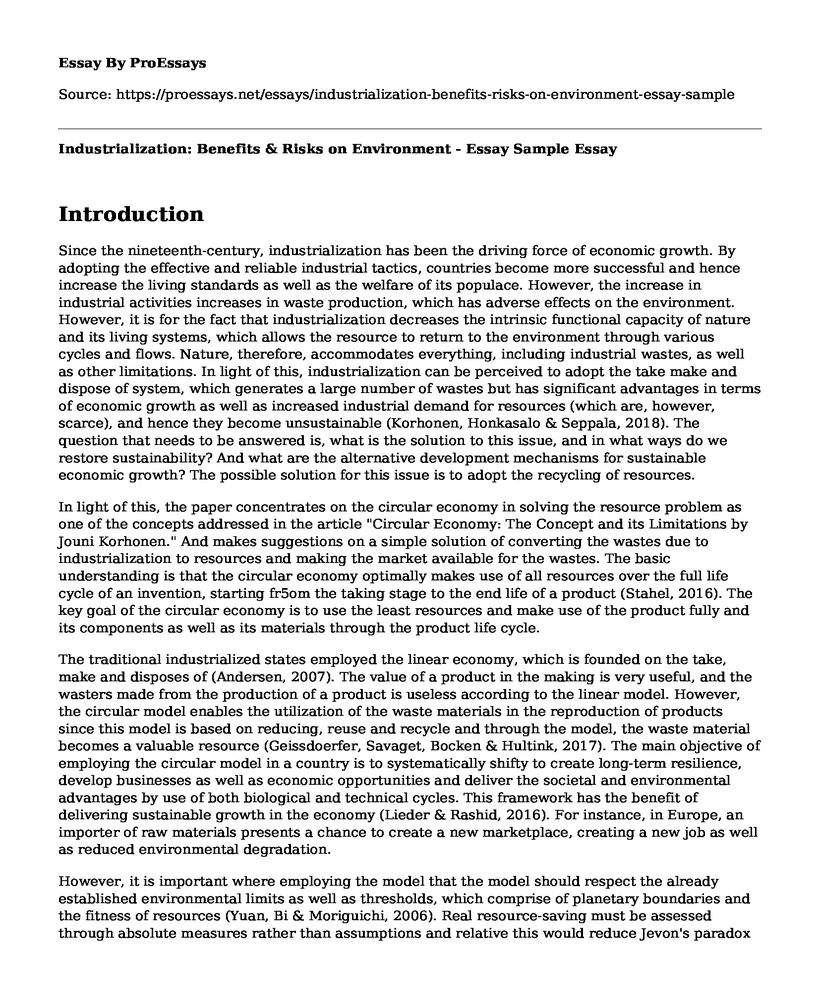Introduction
Since the nineteenth-century, industrialization has been the driving force of economic growth. By adopting the effective and reliable industrial tactics, countries become more successful and hence increase the living standards as well as the welfare of its populace. However, the increase in industrial activities increases in waste production, which has adverse effects on the environment. However, it is for the fact that industrialization decreases the intrinsic functional capacity of nature and its living systems, which allows the resource to return to the environment through various cycles and flows. Nature, therefore, accommodates everything, including industrial wastes, as well as other limitations. In light of this, industrialization can be perceived to adopt the take make and dispose of system, which generates a large number of wastes but has significant advantages in terms of economic growth as well as increased industrial demand for resources (which are, however, scarce), and hence they become unsustainable (Korhonen, Honkasalo & Seppala, 2018). The question that needs to be answered is, what is the solution to this issue, and in what ways do we restore sustainability? And what are the alternative development mechanisms for sustainable economic growth? The possible solution for this issue is to adopt the recycling of resources.
In light of this, the paper concentrates on the circular economy in solving the resource problem as one of the concepts addressed in the article "Circular Economy: The Concept and its Limitations by Jouni Korhonen." And makes suggestions on a simple solution of converting the wastes due to industrialization to resources and making the market available for the wastes. The basic understanding is that the circular economy optimally makes use of all resources over the full life cycle of an invention, starting fr5om the taking stage to the end life of a product (Stahel, 2016). The key goal of the circular economy is to use the least resources and make use of the product fully and its components as well as its materials through the product life cycle.
The traditional industrialized states employed the linear economy, which is founded on the take, make and disposes of (Andersen, 2007). The value of a product in the making is very useful, and the wasters made from the production of a product is useless according to the linear model. However, the circular model enables the utilization of the waste materials in the reproduction of products since this model is based on reducing, reuse and recycle and through the model, the waste material becomes a valuable resource (Geissdoerfer, Savaget, Bocken & Hultink, 2017). The main objective of employing the circular model in a country is to systematically shifty to create long-term resilience, develop businesses as well as economic opportunities and deliver the societal and environmental advantages by use of both biological and technical cycles. This framework has the benefit of delivering sustainable growth in the economy (Lieder & Rashid, 2016). For instance, in Europe, an importer of raw materials presents a chance to create a new marketplace, creating a new job as well as reduced environmental degradation.
However, it is important where employing the model that the model should respect the already established environmental limits as well as thresholds, which comprise of planetary boundaries and the fitness of resources (Yuan, Bi & Moriguichi, 2006). Real resource-saving must be assessed through absolute measures rather than assumptions and relative this would reduce Jevon's paradox as well as have an impact. I addition, the circular economy does not integrate the concepts of environmental and social justice. These aspects must be properly integrated into the model for it to be regarded as better than the linear model.
Conclusion
In conclusion, the circular economic model shows a lot of potential in both sustain growth in the world as well as curb on the issues of environmental degradation. When we think about it will be more beneficial to us when we extract a resource from our surroundings and strive to make it valuable that we continue extracting more benefits from the product instead of disposing of it. On the contrary, although the model is beneficial, it poses certain limitations which ought to be rectified in the future model.
References
Andersen, M. S. (2007). An introductory note on the environmental economics of the circular economy. Sustainability science, 2(1), 133-140. Retrieved from Geissdoerfer, M., Savaget, P., Bocken, N. M., & Hultink, E. J. (2017). The Circular Economy-A new sustainability paradigm? Journal of cleaner production, 143, 757-768. Retrieved from https://www.academia.edu/31149296/The_Circular_Economy_-_A_new_sustainability_paradigm
Korhonen, J., Honkasalo, A., & Seppala, J. (2018). Circular economy: the concept and its limitations. Ecological economics, 143, 37-46. doi: 10.1016/j.ecolecon.2017.06.041
Lieder, M., & Rashid, A. (2016). Towards circular economy implementation: a comprehensive review in context of manufacturing industry. Journal of cleaner production, 115, 36-51. doi: 10.1016/j.jclepro.2015.12.042
Stahel, W. R. (2016). The circular economy. Nature, 531(7595), 435-438. doi: 10.1038/531435a
Yuan, Z., Bi, J., & Moriguichi, Y. (2006). The circular economy: A new development strategy in China. Journal of Industrial Ecology, 10(12), 4-8. doi: 10.1162/108819806775545321
Cite this page
Industrialization: Benefits & Risks on Environment - Essay Sample. (2023, Apr 20). Retrieved from https://proessays.net/essays/industrialization-benefits-risks-on-environment-essay-sample
If you are the original author of this essay and no longer wish to have it published on the ProEssays website, please click below to request its removal:
- Essay on Employment Law in the Twenty-First Century
- How 9/11 Changed the Electrical Industry? - Essay Sample
- Essay Sample on Globalization & Int'lization of Economies: Socio-Cultural, Political & Institutional Aspects
- Medea: Complexity of Athenian Life - Essay Sample
- Cold War: US and USSR Post-WWII Global Politics - Essay Sample
- Essay on Women Pivotal in Civil War: Volunteering, Nursing, Advocating, Spying, and More
- Paper Example on OMB Directive 15: Promoting Integration Through Research on Racial Segregation







